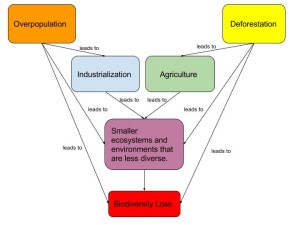Lucas Skiba
4/12/16
Module #10
GEOG 030
Biodiversity: Learning Activity
- Talk about the biodiversity of your home town or where you currently live. Include examples of plants, animals, and other inhabitants and how they contribute to the ecosystem. Should be a paragraph from 150 to 200 words at least.
- In a second paragraph 150 to 200 words, explain some human impacts that are destroying biodiversity. Explain how it effects your hometown and how it effects the whole world.
- Create a system diagram of biodiversity and include the human impacts, and other environmental impacts that effect it.
I currently live in Boalsburg, Pennsylvania. Pennsylvania is home to over 25,000 species of known organisms (I Conserve Pa 2012). There are 800 of these species that are rare or considered endangered which means there is a chance of extinction. I do not believe there is a particularly important species of plant, animal, or organism in Pennsylvania that would be more important than others. But I do believe that every species plays a significant rule in the ecosystems around them. Pennsylvania has a good amount of towns and cities but it also has its fair share of rural land as well. A perfect example of biodiversity loss is in the colony collapse disorder of honey bees. This is a huge impact on Pennsylvania’s biodiversity because honey bees help pollinate most of our crops for food. It is important that we keep our biodiversity very diverse because this can make our ecosystems more resilient and less susceptible to threats. The mountain lion is another animal that people do not know if they are extinct to the northeastern region yet. You may know it better as the “Nittany Lion.” The conclusion is that biodiversity is very important in sustaining our ecosystems that we live in, so it is up to us to protect biodiversity and strive for healthier sustainable environments.
There are many factors that lead to biodiversity loss, but the biggest threat is human impact. Some examples of human impacts would be over harvesting (including hunting, fishing, gathering, etc.), agriculture, over population, pollution, buildings/ industrial factories, etc. I would say the biggest biodiversity losses in Pennsylvania would be from over population, and deforestation for agriculture. Pennsylvania has been using deforestation for a while to produce lumber. Now the forests are cut down for agriculture to grow more crops, because an increase in population means and increase in food. Over population for biodiversity is not just effecting Pennsylvania, but the entire world. Pennsylvania has its fair share of state forests and parks but we need to make sure we are conserving and monitoring our biodiversity in other regions as well. We all need to cut down on population growth and cutting down our forests and focus on alternative and healthier ways to create food and wood to conserve our biodiversity. Our species of animals, vast valleys, and extravagant landscapes of Pennsylvania make it very beautiful place but to conserve this beauty and biodiversity the people are going to have to make changes to everyday life. Biodiversity is how the ecosystems and environments work together as one, so it is important that we keep all living things in a healthy state.
Bibliography/Citation List:
- I Conserve Pennsylvania (2011). Retrieved on April 12, 2016. http://www.iconservepa.org/whyconserve/resourcesindanger/biodiversity/index.htm
- PennState “Probing Question: What’s killing the honeybees?” (2007). Retrieved on April 12, 2016. http://news.psu.edu/story/141186/2007/02/19/research/probing-question-whats-killing-honeybees
- GEOG 030 Module #10 (2015). Retrieved on April 12, 2016. https://www.e-education.psu.edu/geog030/node/397


Hi Lucas. My name is Ben Ceci and I was really interested in your post. Whenever you ask about a person’s hometown, they always take it seriously and ask what can I do to help. Making a diagram and pointing out the factors that are impacting the biodiversity will help people to realize the pros and cons of certain activities and they will know what to do and what to avoid to add more biodiversity. Here is the link to my post if you want to check it out. http://geog030.dutton.psu.edu/2016/04/16/ben-ceci-biodiversity/
Hi Lucas, My name is Avi and I’m a student here at University Park. I enjoyed reading your module and learning about the biodiversity here in Pennsylvania. I was shocked to hear that 800 species here are endangered. Especially out here in central PA, I think the level of agriculture in the area is a large problem for maintaining biodiversity. I also really liked the way your system diagram was laid out.
Her is my module 10 post if you’re interested. https://sites.psu.edu/geog30/wp-admin/post.php?post=58775&action=edit